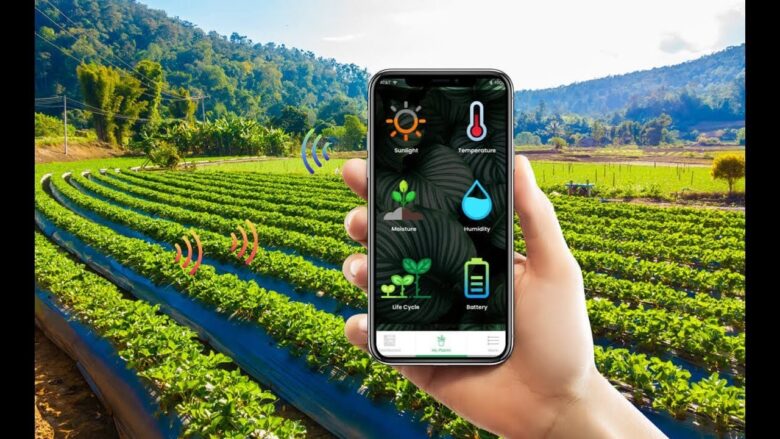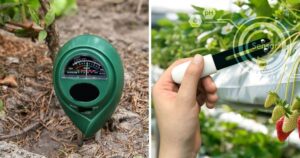Farming and gardening have come a long way in recent years, thanks to the widespread use of technology in many areas of our lives. One of these new ideas is creating smart irrigation systems for gardens. These systems incorporate modern technology to get the most out of water, improve plant health, and make gardening easier. In this article, we discuss the components, pros, and cons of smart irrigation systems and see how they can change the way we care for our gardens.
1. Composition of Intelligent Irrigation System:
- Soil water sensor: The water sensor is the most important part of any smart irrigation system. The intention is that these sensors are placed in the garden soil to measure its moisture content. When soil moisture falls below a certain level, the sensor sends a signal to the irrigation controller. This will start the watering process. This ensures that the plants receive exactly the amount of water they need so that they do not get too much or too little water.
- Irrigation controller: The controller is the brain of a smart irrigation system. It uses data from various sensors and calculates when and how much water to use. Today, most controllers have built-in Wi-Fi, allowing users to monitor and change watering schedules remotely using a dedicated mobile app. This connectivity makes things much easier, especially for those who are always on the go.
- Weather station: The weather station is built into the smart irrigation system, making it more accurate. These stations collect information about temperature, humidity, and forecast rainfall in the area. By looking at this data, irrigation controllers can change the timing of watering plants based on current and expected weather, saving water and ensuring plants receive adequate water.
- Drip Irrigation Systems: Traditional irrigation methods, such as sprinklers, wastewater by evaporation and drainage. Drip irrigation systems are a better way to keep water in the ground. Drip irrigation is often part of a smart irrigation system where water is delivered directly to the roots of plants through a network of pipes and emitters. This method saves water and helps people use water more efficiently, which is better for the environment.
2. Benefits of Smart Irrigation Systems:
- Water conservation: Smart irrigation systems are excellent at saving water because they deliver water exactly where and when it is needed. Being able to vary when plants are watered based on real-time data and weather forecasts can reduce water waste, allowing for more sustainable gardening practices and lower water bills.
- Energy Efficiency: Smart irrigation systems use very little energy because they have energy-efficient components, such as solar sensors and controllers, that allow them to operate. This not only reduces CO2 emissions, it also saves money and ensures that the system lasts longer.
- Plant health and growth: Smart irrigation systems help plants grow better by maintaining proper moisture levels in the soil. You can prevent root rot and mold by watering your plants regularly and in the right places. This also promotes strong root growth. This in turn makes the plants stronger and helps them grow.
- Easy to use: Smart irrigation systems are easy to use for both experienced and novice gardeners as they are intuitively designed and have easy-to-use mobile apps. Being able to remotely observe and control the system makes it easier for users to make changes when they are away from home.
3. Challenges and Considerations:
- Initial costs: Initial costs are one of the biggest problems with smart irrigation systems. Because they use more complex technology and components, the initial cost of these systems can be higher than older methods of watering your plants. However many users believe that the long-term savings and benefits are worth the initial cost.
- Technical difficulty: A smart irrigation system should be easy to use, but some people may find the technical part difficult. Installation and installation may require some technical knowledge, but manufacturers usually provide detailed instructions to make the process easier.
- Reliability and maintenance: The reliability of a smart irrigation system depends on the quality of the components and how well they are maintained. To ensure that the system functions flawlessly, the software must be checked and updated regularly. Users should also be prepared to troubleshoot and resolve any issues immediately.
Conclusion
Smart irrigation systems are a major advancement in garden care because they water plants in a way that is both environmentally friendly and efficient. Soil moisture sensors, controllers, weather stations, and drip irrigation systems can all work together to accurately monitor water usage. This saves water and energy and improves plant health. Although smart irrigation systems can be expensive and difficult to install initially, they are a good investment for gardeners who want to be at the forefront of gardening technology in the future. As these systems continue to improve, they may become important in encouraging gardening practices that are good for the environment and use few resources.
FAQs
1. What is a smart irrigation system and how is it different from traditional methods of watering plants?
A smart irrigation system is an advanced gardening tool that uses technology to get the most out of water. Instead of using traditional methods, it uses controllers, weather stations, soil moisture sensors, and drip irrigation to water plants accurately and efficiently based on real-time data.
2. What is a sensor that measures soil moisture? How do they work in a smart irrigation system?
Placed in garden soil, the soil moisture sensor measures how moist the soil is. When the humidity drops below a certain level, the sensor sends a signal to the irrigation controller. This will start the watering process. This ensures that plants get water when they need it, so they don’t get too much or too little water.
3. What role do irrigation controllers play in making smart irrigation systems work better?
The brain of the system is the irrigation controller, which reads data from various sensors and decides when and how much water to release. Modern controllers often include Wi-Fi connectivity, allowing users to monitor and change watering schedules remotely using a mobile app, making things simpler and more flexible.
4. What role does a weather station play in a smart irrigation system?
Weather stations record information about temperature, and humidity and forecast rainfall. Irrigation controllers look at this data and change the timing of watering plants based on current and expected weather. This feature ensures efficient use of water and no additional water is wasted as irrigation is scheduled based on the weather.
5. Why is drip irrigation often part of a smart irrigation system?
Drip irrigation delivers water through pipes and emitters directly to the roots of plants, reducing the amount of water lost through evaporation and runoff. This approach encourages smart water use, which is good for the environment and is an important part of smart irrigation systems.
6. What are the main benefits of using smart irrigation systems in your garden?
Smart irrigation systems offer many benefits such as water saving, less energy use, making plants healthier, ease of use, etc. These systems get the best out of water, help gardens become more environmentally friendly, and allow you to monitor and control them remotely using a mobile app.



